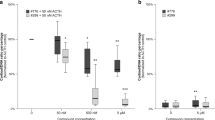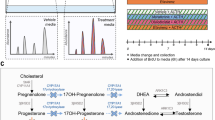Abstract
Dietary chromium(III) picolinate (CrPic) effects on circulating steroid hormones have been reported in various experimental animals. However, direct effects of CrPic on adrenocortical steroidogenesis are uncertain. Therefore, the objective was to determine the effects of CrPic on cortisol and dehydroepiandrosterone sulfate (DHEAs) secretion from H295R cells. In experiment 1, a 24-h exposure to CrPic (0 to 200 μM) had both linear (p < 0.001) and quadratic (p < 0.001) effects on cortisol secretion from forskolin-stimulated cells with the highest cortisol secretion at 0.1 μM of CrPic and the lowest at 200 μM of CrPic. In experiment 2, a 48-h exposure to CrPic (200 μM) decreased cortisol (p < 0.07) release from forskolin-stimulated cells during a 24-h collection period. In experiment 3, a 48-h exposure to CrPic (100 μM) decreased cortisol (p < 0.05) and DHEAs (p < 0.01) from forskolin-stimulated cells during a 24-h sampling period. In experiment 4, a 24-h exposure to forskolin followed by a 24-h exposure to both forskolin and CrPic (100 and 200 μM) decreased both cortisol and DHEAs secretion (p < 0.01). This study suggests that at high concentrations, CrPic inhibits aspects of steroidogenesis in agonist-stimulated adrenocortical cells.




Similar content being viewed by others

References
Anderson RA (1987) Chromium. In: Mertz W (ed) Trace elements in human and animal nutrition. Academic, New York, pp 225–244
Offenbacher EG, Pi-Sunyer FX (1988) Chromium in human nutrition. Annu Rev Nutr 8:543–563
Schwarz K, Mertz W (1959) Chromium(III) and the glucose tolerance factor. Arch Biochem Biophys 85:292–295
Mertz W, Toepfer EW, Roginski EE, Polansky MM (1974) Present knowledge of the role of chromium. Fed Proc 33:2275–2280
Vincent JB (2000) The biochemistry of chromium. J Nutr 130:715–718
Evans GW, Bowman TD (1992) Chromium picolinate increases membrane fluidity and rate of insulin internalization. J Inorg Biochem 46:243–250
Moonsie-Shageer S, Mowat DN (1993) Effect of level of supplemental chromium on performance, serum constituents, and immune response of stressed feeder steer calves. J Anim Sci 71:232–238
Mowat DN, Chang X, Yang WZ (1993) Chelated chromium for stressed feeder calves. Can J Anim Sci 73:49–55
Gentry LR, Fernandez JM, Ward TL, White TW, Southern LL, Bidner TD, Thompson DL, Horohov DW, Chapa AM, Sahlu T (1999) Dietary protein and chromium tripicolinate in Suffolk wether lambs: Effects on production characteristics, metabolic and hormonal responses, and immune status. J Anim Sci 77:1284–1294
Pechova A, Pavlata L, Illek J (2002) Metabolic effects of chromium administration to dairy cows in the period of stress. Czech J Anim Sci 47:1–7
Roussel AM, Bureau I, Favier M, Polansky MM, Bryden NA, Anderson RA (2002) Beneficial effects of hormonal replacement therapy on chromium status and glucose and lipid metabolism in postmenopausal women. Maturitas 42:63–69
van Heugten E, Spears JW (1997) Immune response and growth of stressed weanling pigs fed diets supplemented with organic or inorganic forms of chromium. J Anim Sci 75:409–416
Baldi A, Bontempo V, Dell'Orto V, Cheli F, Fantuz F, Savoini G (1999) Effects of dietary chromium-yeast in weaning-stressed piglets. Can J Anim Sci 79:369–374
Pollard GV, Richardson CR, Kamezos TP (2002) Effects of supplemental organic chromium on growth, feed efficiency and carcass characteristics of feedlot steers. Anim Feed Sci Technol 98:121–128
Kim BG, Lindemann MD, Cromwell GL (2009) The effects of dietary chromium(III) picolinate on growth performance, blood measurements, and respiratory rate in pigs kept in high and low ambient temperature. J Anim Sci 87:1695–1704
Ghafghazi T, McDaniel ML, Lacey PE (1980) Chromium-induced inhibition of insulin secretion from isolated islets of Langerhans. Diabetologia 18:229–232
Liu P, Lin M (1997) Biphasic effects of chromium compounds on catecholamine secretion from bovine adrenal medullary cells. Toxicol 117:45–53
Gazdar AF, Oie HK, Shackleton CH, Chen TR, Triche TJ, Myers CE, Chrousos GP, Brennan MF, Stein CA, La Rocca RV (1990) Establishment and characterization of a human adrenocortical carcinoma cell line that expresses multiple pathways of steroid biosynthesis. Cancer Res 50:5488–5496
Rainey WE, Bird IM, Sawetawan C, Hanley NA, McCarthy JL, McGee EA, Wester R, Mason JI (1993) Regulation of human adrenal carcinoma cell (NCI-H295) production of C19 steroids. J Clin Endocrinol Metab 77:731–737
Staels B, Hum DW, Miller WL (1993) Regulation of steroidogenesis in NCI-H295 cells—a cellular-model of the human fetal adrenal. Mol Endocrinol 7:423–433
Rainey WE, Bird IM, Mason JI (1994) The NCI-H295 cell line: a pluripotent model for human adrenocortical studies. Mol Cell Endocrinol 100:45–50
Rainey WE, Saner K, Schimmer BP (2004) Adrenocortical cell lines. Mol Cell Endocrinol 228:23–38
Vakharia K, Hinson JP (2005) Lipopolysaccharide directly stimulates cortisol secretion by human adrenal cells by a cyclooxygenase-dependent mechanism. Endocrinol 146:1398–1402
Oskarsson A, Ulleras E, Plant KE, Hinson JP, Goldfarb PS (2006) Steroidogenic gene expression in H295R cells and the human adrenal gland: adrenotoxic effects of lindane in vitro. J Appl Toxicol 26:484–492
Mikhaylova IV, Kuulasmaa T, Jaaskelainen J, Voutilainen R (2007) Tumor necrosis factor-alpha regulates steroidogenesis, apoptosis, and cell viability in the human adrenocortical cell line NCI-H295R. Endocrinol 148:386–392
Gell JS, Oh J, Rainey WE, Carr BR (1988) Effect of estradiol on DHEAS production in the human adrenocortical cell line, H295R. Reprod Sci 5:144–148
Ehrhart-Bornstein M, Lamounier-Zepter V, Schraven A, Langenbach J, Willenberg HS, Barthel A, Hauner H, McCann SM, Scherbaum WA, Bornstein SR (2003) Human adipocytes secrete mineralocorticoid-releasing factors. Proc Natl Acad Sci U S A 100:14211–14216
Institute SAS (1996) SAS Users Guide. SAS institute, Cary
Penhoat A, Naville D, El Mourabit H, Buronfosse A, Durand P, Begeot M (2000) Functional expression of the human ACTH receptor gene. Endocr Res 26:549–557
Seamon KB, Padgett W, Daly JW (1981) Forskolin: unique diterpene activator of adenylate cyclase in membranes and in intact cells. Proc Natl Acad Sci U S A 78:3363–3367
Litvin Y, Pasmantier R, Fleischer N, Erlichman J (1984) Hormonal activation of the cAMP-dependent protein-kinases in Att20 cells—preferential activation of protein kinase-I by corticotropin releasing-factor, isoproterenol, and forskolin. J Biol Chem 259:296–302
Ding X, Staudinger JL (2005) Induction of drug metabolism by forskolin: the role of the pregnane X receptor and the protein kinase A signal transduction pathway. J Pharmacol Exp Ther 312:849–856
Page TG, Southern LL, Ward TL, Thompson DL Jr (1993) Effect of chromium picolinate on growth and serum and carcass traits of growing-finishing pigs. J Anim Sci 71:656–662
Chang X, Mowat DN (1992) Supplemental chromium for stressed and growing feeder calves. J Anim Sci 70:559–565
Anderson RA, Bryden NA, Polansky MM, Gautschi K (1996) Dietary chromium effects on tissue chromium concentrations and chromium absorption in rats. J Trace Elem Exp Med 9:11–25
Lindemann MD, Cromwell GL, Monegue HJ, Purser KW (2008) Effect of chromium source on tissue concentration of chromium in pigs. J Anim Sci 86:2971–2978
Lindemann MD, Carter SD, Chiba LI, Dove CR, LeMieux FM, Southern LL (2004) A regional evaluation of chromium tripicolinate supplementation of diets fed to reproducing sows. J Anim Sci 82:2972–2977
Cerulli J, Grabe DW, Gauthier I, Malone M, McGoldrick MD (1998) Chromium picolinate toxicity. Ann Pharmacother 32:428–431
Asif AR (2004) Role of transport systems in cortisol release from human adrenal cells, PhD dissertation. Georg-August-Universität, Göttingen, Germany
Bird IM, Mason JI, Rainey WE (1998) Battle of the kinases: integration of adrenal responses to cAMP, DG and Ca2+ at the level of steroidogenic cytochromes P450 and 3betaHSD expression in H295R cells. Endocr Res 24:345–354
Zenkert S, Schubert B, Fassnacht M, Beuschlein F, Allolio B, Reincke M (2000) Steroidogenic acute regulatory protein mRNA expression in adrenal tumours. Eur J Endocrinol 142:294–299
Asif AR, Ljubojevic M, Sabolic I, Shnitsar V, Metten M, Anzai N, Muller GA, Burckhardt G, Hagos Y (2006) Regulation of steroid hormone biosynthesis enzymes and organic anion transporters by forskolin and DHEA-S treatment in adrenocortical cells. Am J Physiol Endocrinol Metab 291:E1351–E1359
Acknowledgements
The authors thank Mrs. S. Hayes, University of Kentucky, for assistance in radioimmunoassay, and Dr. R. A. Anderson, USDA-ARS, and Dr. J. C. Matthews, University of Kentucky, for helpful comments. Special appreciation is expressed to Nutrition 21, Purchase, NY, for partial support for this study. During this research, B. G. Kim was a recipient of the Presidential Graduate Fellowship and the Kentucky Opportunity Fellowship at the University of Kentucky.
Author information
Authors and Affiliations
Corresponding author
Rights and permissions
About this article
Cite this article
Kim, B.G., Adams, J.M., Jackson, B.A. et al. Effects of Chromium(III) Picolinate on Cortisol and DHEAs Secretion in H295R Human Adrenocortical Cells. Biol Trace Elem Res 133, 171–180 (2010). https://doi.org/10.1007/s12011-009-8433-7
Received:
Accepted:
Published:
Issue Date:
DOI: https://doi.org/10.1007/s12011-009-8433-7



